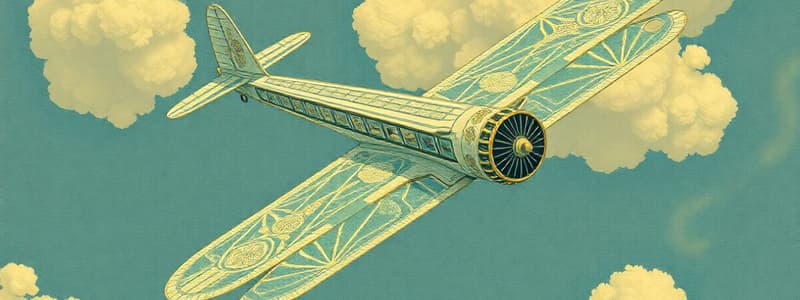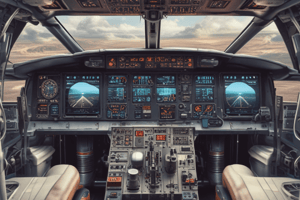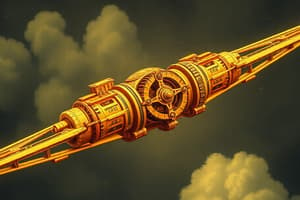Podcast
Questions and Answers
What is the primary function of ailerons on an aircraft's wings?
What is the primary function of ailerons on an aircraft's wings?
- To control the aircraft's altitude by adjusting lift.
- To increase drag and slow down the aircraft.
- To control the aircraft's roll, enabling it to bank and turn. (correct)
- To provide additional lift during takeoff and landing.
What is aileron drag (adverse yaw)?
What is aileron drag (adverse yaw)?
- The increased parasite drag when both ailerons are deflected downwards.
- The decrease in lift caused by deploying ailerons.
- The additional lift generated by the downward-moving aileron.
- The tendency of the aircraft's nose to yaw in the opposite direction of the intended turn. (correct)
How do differential ailerons minimize adverse yaw?
How do differential ailerons minimize adverse yaw?
- By using spoilers on the wings to create equal drag.
- By having the upward-moving aileron travel a greater distance than the downward-moving aileron. (correct)
- By deflecting both ailerons upwards to reduce overall drag.
- By causing both ailerons to move downward, increasing lift equally on both wings.
How do Frise ailerons work to reduce adverse yaw?
How do Frise ailerons work to reduce adverse yaw?
What is the function of roll spoilers in conjunction with ailerons?
What is the function of roll spoilers in conjunction with ailerons?
If a pilot turns the control wheel to the right, what movement do the ailerons make?
If a pilot turns the control wheel to the right, what movement do the ailerons make?
During a roll to the right, which of the following is true regarding lift and drag?
During a roll to the right, which of the following is true regarding lift and drag?
Which design feature is primarily responsible for counteracting the increased induced drag caused by a lowered aileron?
Which design feature is primarily responsible for counteracting the increased induced drag caused by a lowered aileron?
Spoilers on transport category aircraft are primarily used for all of the following EXCEPT:
Spoilers on transport category aircraft are primarily used for all of the following EXCEPT:
If a pilot pushes the control wheel forward in an aircraft equipped with elevators, what is the immediate effect on the elevators and the aircraft's pitch?
If a pilot pushes the control wheel forward in an aircraft equipped with elevators, what is the immediate effect on the elevators and the aircraft's pitch?
What is the primary purpose of an anti-balance tab on a stabilator?
What is the primary purpose of an anti-balance tab on a stabilator?
How does pulling back on the control wheel affect a stabilator?
How does pulling back on the control wheel affect a stabilator?
In a coordinated turn using ailerons and spoilers, what approximate percentage of the roll rate is attributed to the spoilers when a large amount of aileron input is used?
In a coordinated turn using ailerons and spoilers, what approximate percentage of the roll rate is attributed to the spoilers when a large amount of aileron input is used?
Which of the following best describes how elevators control an aircraft?
Which of the following best describes how elevators control an aircraft?
What distinguishes a stabilator from a traditional horizontal stabilizer and elevator configuration?
What distinguishes a stabilator from a traditional horizontal stabilizer and elevator configuration?
How does the movement of an anti-balance tab correspond to the movement of the stabilator?
How does the movement of an anti-balance tab correspond to the movement of the stabilator?
Flashcards
Ailerons
Ailerons
Control surfaces on wings that move in opposite directions to control roll.
Adverse Yaw
Adverse Yaw
The undesired nose movement in the opposite direction during a turn due to aileron drag.
Aileron Drag
Aileron Drag
Increased drag caused by ailerons moving, especially the downward moving aileron.
Differential Ailerons
Differential Ailerons
Signup and view all the flashcards
Frise Ailerons
Frise Ailerons
Signup and view all the flashcards
Roll Spoilers
Roll Spoilers
Signup and view all the flashcards
Control Wheel
Control Wheel
Signup and view all the flashcards
Lift and Drag
Lift and Drag
Signup and view all the flashcards
Parasite Drag
Parasite Drag
Signup and view all the flashcards
Spoilers
Spoilers
Signup and view all the flashcards
Elevators
Elevators
Signup and view all the flashcards
Lateral Axis
Lateral Axis
Signup and view all the flashcards
Stabilator
Stabilator
Signup and view all the flashcards
Anti-Balance Tab
Anti-Balance Tab
Signup and view all the flashcards
Study Notes
Ailerons
- Ailerons are control surfaces on the trailing edge of wings
- Located from the wing midpoint to the tip
- Function in opposite directions
- Moving one aileron up, moves the other down
- Operated by the cockpit control wheel
- Left aileron up/right aileron down = turn left
- Right aileron up/left aileron down = turn right
Aileron Drag (Adverse Yaw)
- Aileron displacement creates undesirable aileron drag
- Downward-moving aileron generates more lift and drag
- Wingtip drag pulls the aircraft's nose in the opposite direction of the turn (adverse yaw)
- A significant issue during turns
- During a bank to the right, additional drag from the down- moving left aileron causes a nose-dive to the left.
Differential Ailerons
- Minimises adverse yaw effect
- Upward-moving aileron travels further than the downward-moving aileron
- Creates extra parasite drag to balance induced drag
Frise Ailerons
- Another method to mitigate adverse yaw
- The up-going aileron's leading edge extends below the wing's underside
- Increases parasite drag to counteract induced drag
Roll Spoilers
- Hinged surfaces located above the flaps on the upper wing surface
- Usually flush with the wing surface, having no impact on the airfoil's performance
- Connected to aileron controls; aileron movement triggers spoiler deployment
- Deploy to reduce lift on the lowered-wing side
- Generate additional parasite drag to counteract adverse yaw
- In large aileron movements, account for about 80% of the roll rate
- Employed in transport aircraft for secondary flight control
Elevators
- Horizontal control surfaces on the aircraft tail
- Cause rotation about the lateral axis (nose-up/nose-down)
- Elevator movement is directly linked to control wheel input
- Pulling back the control wheel moves the elevator up, lifting the nose
- Pushing the control wheel forward moves the elevator down, lowering the nose.
Stabilator
- A type of horizontal tail surface (all-movable tail)
- No fixed stabiliser, features an anti-balance tab on the trailing edge
- Anti-balance tab reduces excessive sensitivity
- Controlled by the control wheel in the cockpit
- Pulling back the control wheel causes the leading edge of the stabilator to move down and increases the downward force from the tail, generating a nose-up turn.
- Pushing the control wheel forward moves the stabilator leading edge up, lowering the tail load and resulting in a nose-down turn.
Studying That Suits You
Use AI to generate personalized quizzes and flashcards to suit your learning preferences.
Description
This text describes ailerons, control surfaces on the trailing edge of wings that function in opposite directions to control an aircraft's roll. Aileron drag can create adverse yaw. Differential ailerons and Frise ailerons are methods to mitigate adverse yaw.




